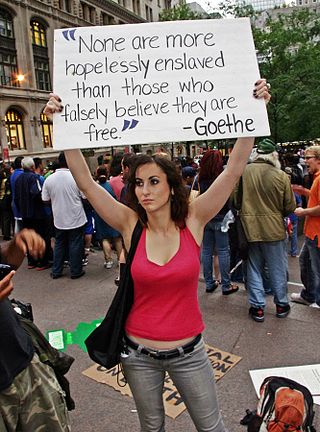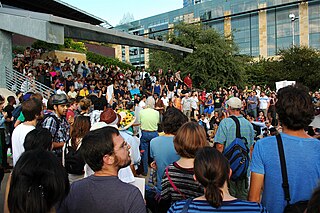Democracy movements of China are a series of organized political movements, inside and outside of China, addressing a variety of grievances, including objections to socialist bureaucratism and objections to the continuation of the one-party rule of the Chinese Communist Party (CCP) itself. The Democracy Wall movement of November 1978 to spring 1981 is typically regarded as the beginning of contemporary Chinese democracy movement. In addition to the Democracy Wall movement, the events of the 1989 Tiananmen Square protests and massacre are among the notable examples of Chinese democracy movements.

Internet activism, hacktivism, or hactivism, is the use of computer-based techniques such as hacking as a form of civil disobedience to promote a political agenda or social change. With roots in hacker culture and hacker ethics, its ends are often related to free speech, human rights, or freedom of information movements.

A social movement is a loosely organized effort by a large group of people to achieve a particular goal, typically a social or political one. This may be to carry out a social change, or to resist or undo one. It is a type of group action and may involve individuals, organizations, or both. Social movements have been described as "organizational structures and strategies that may empower oppressed populations to mount effective challenges and resist the more powerful and advantaged elites". They represent a method of social change from the bottom within nations. On the other hand, some social movements do not aim to make society more egalitarian, but to maintain or amplify existing power relationships. For example, scholars have described fascism as a social movement.

Media activism is a broad category of activism that utilizes media and communication technologies for social and political movements. Methods of media activism include publishing news on websites, creating video and audio investigations, spreading information about protests, or organizing campaigns relating to media and communications policies.

As an act of protest, occupation is a strategy often used by social movements and other forms of collective social action in order to squat and hold public and symbolic spaces, buildings, critical infrastructure such as entrances to train stations, shopping centers, university buildings, squares, and parks. Opposed to a military occupation which attempts to subdue a conquered country, a protest occupation is a means to resist the status quo and advocate a change in public policy. Occupation attempts to use space as an instrument in order to achieve political and economic change, and to construct counter-spaces in which protesters express their desire to participate in the production and re-imagination of urban space. Often, this is connected to the right to the city, which is the right to inhabit and be in the city as well as to redefine the city in ways that challenge the demands of capitalist accumulation. That is to make public spaces more valuable to the citizens in contrast to favoring the interests of corporate and financial capital.

¡Democracia Real YA!, also known as Plataforma Democracia Real Ya!, is a Spanish grassroots organization that started in March 2011 in Madrid, Spain. It sparked the political movement of May 15, 2011 (15M) whose protests gained worldwide attention. The protests been compared to the May 1968 social movement in France.

Occupy Wall Street (OWS) was a left-wing populist movement against economic inequality, corporate greed, big finance, and the influence of money in politics that began in Zuccotti Park, located in New York City's Financial District, and lasted for fifty-nine days—from September 17 to November 15, 2011.

The following is a timeline of Occupy Wall Street (OWS), a protest which began on September 17, 2011 on Wall Street, the financial district of New York City and included the occupation of Zuccotti Park, where protesters established a permanent encampment. The Occupy movement splintered after NYC Mayor Bloomberg had police raid the encampment in Zuccotti Park on November 15, 2011. The timeline here is limited to this particular protest during this approximate time-frame.

Occupy San José was a peaceful protest and demonstration in City Hall Plaza in San Jose, California. The demonstration was inspired by Occupy Wall Street and is part of the larger "Occupy" protest movement. The aim of the demonstration was to begin a sustained occupation in downtown San José, the 10th largest city in the United States, to protest perceived corporate greed and social inequality, including opposing corporate influence in U.S. politics, the influence of money and corporations on democracy and a lack of legal and political repercussions for the 2007–2008 financial crisis.
Occupy Ashland included a peaceful protest and demonstration against economic inequality, corporate greed and the influence of corporations and lobbyists on government which has taken place in Ashland, Oregon, United States since 6 October 2011. The protests began in solidarity with the Occupy Wall Street protests in New York. The protests included an occupation of the downtown Plaza and a daily picket outside the JPMorgan Chase branch in Ashland.

The Occupy movement was an international populist socio-political movement that expressed opposition to social and economic inequality and to the perceived lack of real democracy around the world. It aimed primarily to advance social and economic justice and different forms of democracy. The movement has had many different scopes, since local groups often had different focuses, but its prime concerns included how large corporations and the global financial system control the world in a way that disproportionately benefits a minority, undermines democracy and causes instability.

Occupy Austin was a collaboration that began on October 6, 2011 at City Hall in Austin, Texas as an occupation and peaceful protest. It is affiliated with the Occupy Wall Street movement that began in New York City, and also with the "Occupy" protests in the United States and around the world. At the center of the occupation is the General Assembly, where the community comes out and tries to come to consensus on proposals for action.

Occupy London was a political movement in London, England, and part of the international Occupy movement. While some media described it as an "anti-capitalist" movement, in the statement written and endorsed by consensus by the Occupy assembly in the first two days of the occupation, occupiers defined themselves as a movement working to create alternatives to an "unjust and undemocratic" system. A second statement endorsed the following day called for "real global democracy". Due to a pre-emptive injunction, the protesters were prevented from their original aim to camp outside the London Stock Exchange. A camp was set up nearby next to St Paul's Cathedral. On 18 January 2012, Mr Justice Lindblom granted an injunction against continuation of the protest but the protesters remained in place pending an appeal. The appeal was refused on 22 February, and just past midnight on 28 February, bailiffs supported by City of London Police began to remove the tents.

Occupy Houston is a Houston, Texas-based activist group best known for alleged plots against it by the Federal Bureau of Investigation, investigated and called out on in court by Occupy protester Ryan Shapiro, and for being set up by the Austin Police Department. Occupy Houston was a collaboration that has included occupation protests that stand in solidarity with Occupy Wall Street. The planned occupation officially started in Houston, Texas on Thursday October 6, 2011 when protesters returned from JP Morgan Chase Tower to establish an encampment at Hermann Square Plaza. During the JPMorgan Chase demonstration there were not any confrontations with the police and numerous different passerby were reported to have sympathized with the tone of the protesters. That same night the police were reported to have commented on how well behaved the protesters were.

The 99 Percent Declaration or 99% Declaration is a not-for-profit organization based in Kentucky that originated from a working group of the Occupy Wall Street (OWS) movement in Zuccotti Park, New York City, in October 2011. The organization published a document calling for a "National General Assembly" to be held beginning the week of July 4, 2012 in Philadelphia, which was rejected by the general assemblies of OWS and Occupy Philadelphia. The Declaration includes demands for an immediate ban on all monetary and gift contributions to all politicians, implementation of a public financing system for political campaigns, and the enactment of an amendment to the United States Constitution overturning the Supreme Court's Citizens United v. FEC decision.

The Occupy movement spread to many other cities in the United States and worldwide beginning with the Occupy Wall Street protests in New York City in September 2011. The movement sought to advance social and economic justice and different forms of democracy but each local group varied in specific aims. The demonstrations and encampment in New York City spread to other major and smaller cities. Some camps lasted through 2012. What follows is an alphabetical, non-chronological summary of Occupy encampments in the United States.

Occupy Comics: Art & Stories Inspired by Occupy Wall Street is a three-issue comic book anthology series published by Black Mask Studios in 2013. Funded on Kickstarter, the series articulates themes of the Occupy Wall Street movement through comics as well as fund-raises on behalf of the protesters.

Occupy Redwood City was a collaboration that began with peaceful protests, demonstrations, and general assemblies in front of the historic San Mateo County Courthouse in Redwood City, California. The demonstration was inspired by Occupy Wall Street and is part of the larger "Occupy" protest movement.
The Occupy Wall Street demonstrations garnered reactions of both praise and criticism from organizations and public figures in many parts of the world. Over time, a long list of notable people from a range of backgrounds began and continue to lend their support or make reference to the Occupy movement in general.















